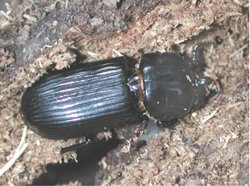Passalidae
|
|
| Passalidae | ||||||||||||
|---|---|---|---|---|---|---|---|---|---|---|---|---|
 Adult bessbug, Odontotaenius disjunctus from rotting log in Hemingway, South Carolina | ||||||||||||
| Scientific classification | ||||||||||||
| ||||||||||||
| Genera | ||||||||||||
| Missing image Bessbuglarva2654.jpg Bessbug larva Bessbug larva |
In the eastern U.S. and Canada, the Bessbug (Passalidae) is a very large beetle at about 2.5 cm (1 inch) both as an adult and a larva, that feeds on rotting wood. It has a "horn" on the dorsal head. They are highly subsocial beetles that care for the young; they prepare food for them and help the larvae construct the pupal case. Fourteen acoustical signals are known for the family, more than many vertebrates. Adults produce sound by rubbing the upper surface of the abdomen against the hind wings. Larvae produce sounds by rubbing the third leg against a striated area on the coxa of the second leg. O. floridanus is known only from Florida on sand hills that used to be islands when Florida was flooded thousands of years ago. Ptichopus angulatus was recently discovered near the border of Mexico in Arizona. It occurs south to Colombia associated with detritus chambers of leaf-cutter ant nests (Atta sp.). Two other species were reported from Arizona at the beginning of the 20th century, but haven't been seen there since that time; they may have been brought from Mexico by train hauling firewood.
